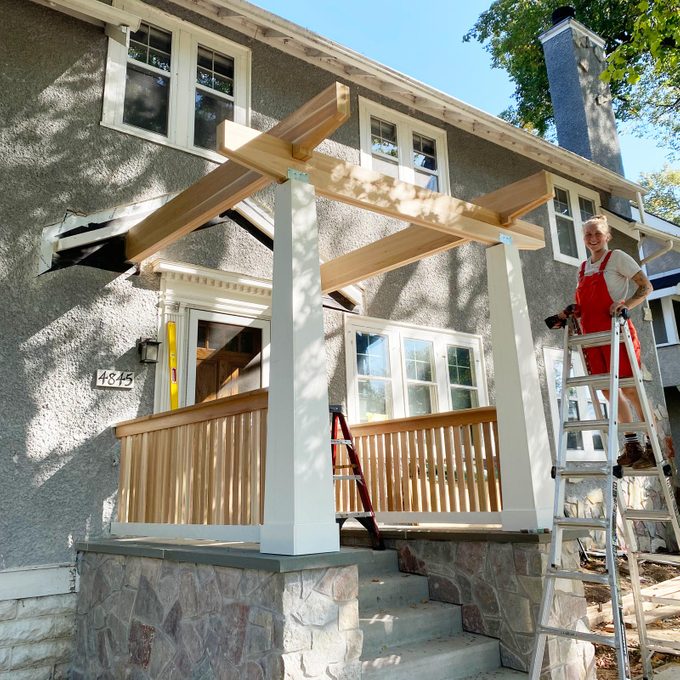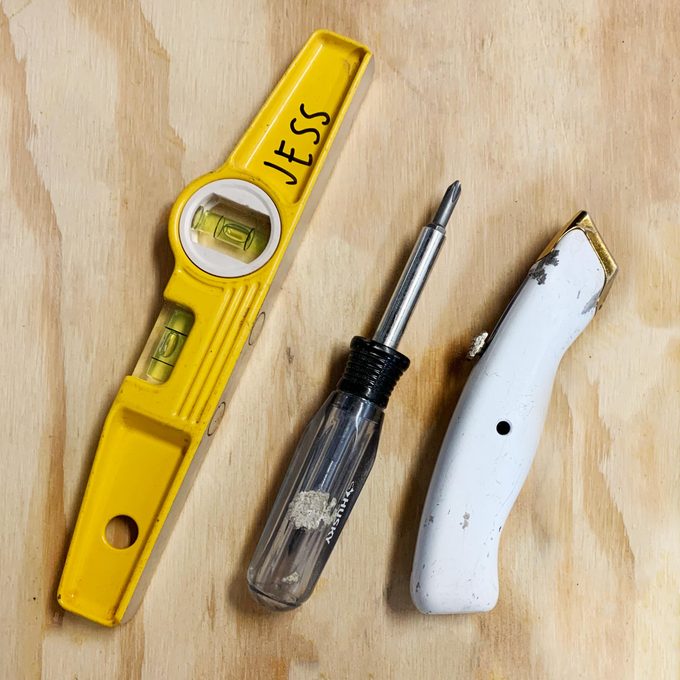This FH series introduces readers to a few of the women who make up 11 percent of the construction workforce in the U. S., spotlighting stories of their careers in the field. Know someone we should feature? Email us here.
From cutting bathroom trim to carving dough bowls with Norse tools, Jess Hirsch loves all things wood.
“I like the intimacy of working with wood,” she says. “I just have an affinity to the material because of its organic nature, how you have to have this physical dance while shaping it, and how it’s connected to the landscape. It constructs our homes, stirs our food, and can be purely an object of beauty.”
Since earning a master’s degree in fine arts from the University of Minnesota in 2013, Hirsch has worked primarily as a sculpture artist. She founded the nonprofit Fireweed Community Woodshop, which helps empower women and non-binary people through teaching woodcraft. Classes range from DIY renovation to furniture making to basket weaving. Hirsch personally teaches bowl turning and spoon carving.
When COVID-19 hit, she closed the woodshop and move classes online. That sudden work instability prompted her to enter a new phase of her career: construction. In 2021 she started as an apprentice carpenter with Terra Firma, a Minnesota-based remodeling and building company.
“Carpentry has been a really fun jump into more practical, utilitarian projects,” she says. “Working on houses feels like an interactive wood sculpture in a lot of ways. I love helping a space transform from a flat idea into the 3D world.”
Hirsch also became a mom in March 2022. We caught up with her during her maternity leave for her thoughts on the state of the woodworking industry.
Q: You’ve mainly worked as an artist, so how did you get into carpentry?
A: I bought my duplex five years ago and remodeled both kitchens and bathrooms, plus worked on some home renovations through Fireweed, so I’d definitely gotten my feet wet in advance of getting hired by Terra Firma.
I think the beauty of my art background is that I’m familiar with all of the tools and problem solving. Then it’s just a matter of understanding the engineering of a house. I think DIY house projects are a great way to get into woodworking as well. You learn a lot, especially when your house is 100 years old like mine.
Q: Why teach classes specifically to women and non-binary people?
A: I really want to create a space where people know they’re going to be supported, and that if they’re bad at it, it’s because they’re a beginner, not because they’re a woman or not a man.
When I started 19 years ago, there weren’t a lot of women or gender nonconforming people taking the classes I was taking. In workshops, I felt a little bit like an anomaly, a zoo animal on display. I even had a professor ask, “So why are women making sculpture now?”
Feeling included and supported is important because woodworking is so empowering. I was building a sculpture at a battered women’s shelter and teaching this 12-year-old girl there how to use the power tools. I could see her confidence grow and explode.
I realized the educational aspect of woodworking was more powerful than the sculpture we were building. And I was like, I need to teach. I need to put tools in people’s hands. You gain a ton of confidence when you feel like, “Oh yeah, I can built that.” It’s pretty sweet to share these tools with people.
Q: Which projects stand out to you?

A. I have a piece at Franconia Sculpture Park. It’s a three-tiered coffin with a 21-ft.-long base. The coffins get smaller as they go up, and you can lay on the top coffin, which is human scale and exactly six feet above the ground. The top part is cast concrete with gemstones in it, and the second tier houses plants from the energetic medicinal world.
The prompt I give people is to lay on the slab and contemplate your death, with the support of the plants and the gemstones. It’s a beautiful experience because you’re elevated and focusing on the blue sky in a fairly peaceful field.
There’s also a three-story home addition I did with Terra Firma. I was the cut guy, as they call it. It was just me on the ground, cutting all the framing and sheathing and passing it up to my coworkers.
It was pretty satisfying to watch it be built, also while being pregnant in hundred-degree weather. I felt very accomplished to survive that. And it’s a very beautiful home now. I like to think about the houses and all of the stories that will happen within them.
Q: What changes have you seen in woodworking over the past 10 years?
A: I’ve seen a huge influx of women and non-binary people getting into the trades. For Fireweed, a lot of our classes have sold out immediately. So there’s high, high demand for it. And I think that people are definitely more welcoming in general.
I’ve also had really awesome experiences with mentors who are advocates for getting women into the trades. The environment is definitely shifting. It’s not 100 percent, but it’s shifting, and that feels really exciting.
Q: Where do you hope to see the industry in 10 years?
A: I would like it to be totally normalized for a woman to be on the jobsite.
Sometimes I’ll show up at a client’s house, and even though I’m wearing my shirt that says Terra Firma, they’ll ask, “Who are you?” Or people will say, “Oh, I thought you were a man until you started talking.”
I would like for it to just be, “Hi, how are you? So glad you’re here to help remodel my kitchen.” So that’s the goal. Just to be a woodworker, not a woman woodworker.
Q: Any pros or cons to being a woman in woodworking and carpentry?
A: The challenging aspect is the mental game. Sometimes I feel like I’m being judged preemptively because I’m a woman, and that I don’t have room to fail if I want to be taken seriously. That can really defeat the fun aspects of the process, because of the perfectionism I then hold myself to. It 100 percent does not have to do with my co-workers. It’s more of a societal pressure.
There are benefits, too. There’s great camaraderie and support, because people know how hard it is to get into woodworking when you’re femme, and they become your allies. Camaraderie formed through that hardship is quite special.
Being pregnant was also challenging. Besides the physical aspects of working through it, there’s not a lot of information out there on how to navigate being a pregnant carpenter. Midwives had to research my questions, like could the decibels of my power tools affect the hearing of the baby. We never really found an answer to that one.
Q: Any advice for young women looking to get into carpentry and woodworking?
A: Fireweed offers an annual “getting into the trades” panel, which is really informative because you can ask people at various levels what their experience has been like working in the trades.
So I’d say, have an informal meeting with someone in the trades to get a sense of it, or just try tinkering around in your own house. As woodworker Daej Hamilton says, go rev your drill a few times. That might be enough to give you the momentum to do more.
Q: What are your pro-specific tools?

A: I have three to five different tool bags, depending on what I’m working on.
In my green woodworking tool bag, I’m definitely going to have a Kalthoff carving axe. There’s a blacksmith in Sweden who makes them. They’re superb because they’re lightweight, which makes them easier on the wrists, but they cut like a big axe, because of their profile. And then I have my small Karlsson adze, which I like because it’s ergonomic and also lightweight but powerful, plus aluminum wedges from Sweden, and my favorite Imanishi sharpening stones.
My carpentry toolbox is very full, but you have to have a good tape measure, chalk line, utility knife, lots of drills, a good impact driver, and all of the pry bars. Also, my screwdriver has four different tip options. If you get smart tools, your tool bag is going to be less heavy on your hips, and it’s nice to be easier on your body if you can.
Listing the turning tools would be like a half-hour spiel, so I’ll just leave it at that.
Jess Hirsch Bio
Jess Hirsch has been working with wood for 19 years through various forms of sculpture, craft and carpentry. She founded and teaches at the nonprofit Fireweed Community Woodshop, which empowers women and non-binary people through learning woodcrafts.
She also works as a production carpenter for the building and remodeling firm Terra Firma. She holds a master’s degree in sculpture and has won several grants and awards, including from the Minnesota State Arts Board and American Scandinavian Foundation.
Writer Karuna Eberl Bio
Karuna Eberl is a regular contributor to FamilyHandyman.com. She has spent the last 25 years as a freelance journalist and filmmaker, telling stories of people, nature, travel, science and history. She has won numerous awards for her writing, her Florida Keys Travel Guide and her documentary, The Guerrero Project.
Article source here: The Eleven Percent: Meet Jess Hirsch, Carpenter and Woodworker


No comments:
Post a Comment